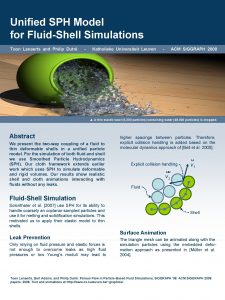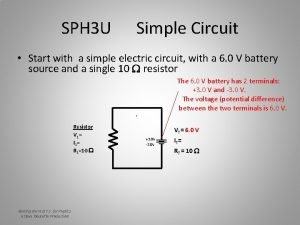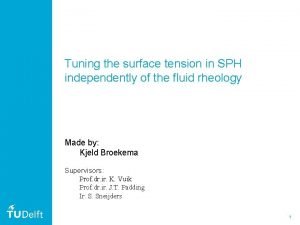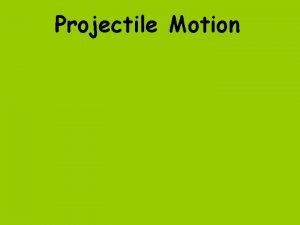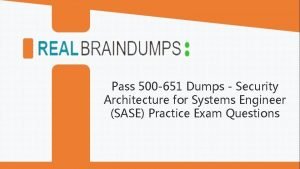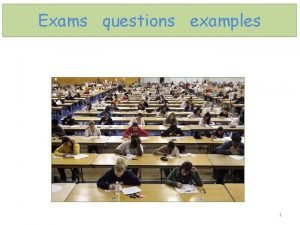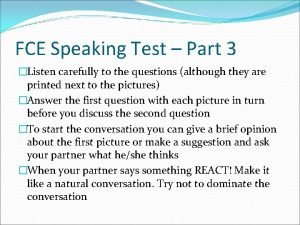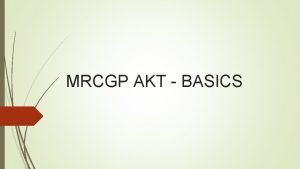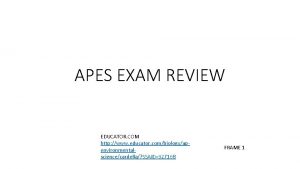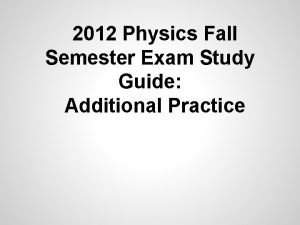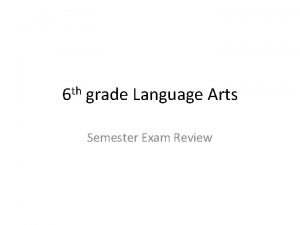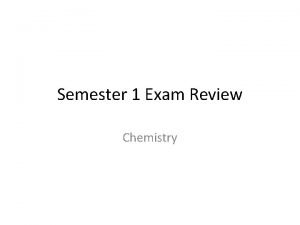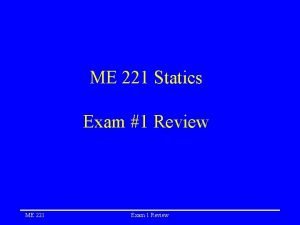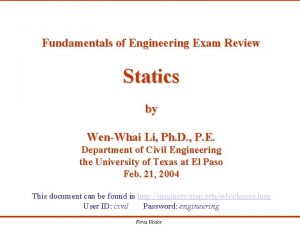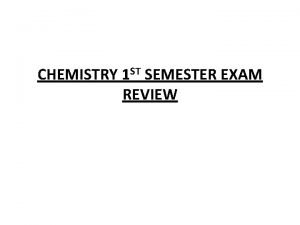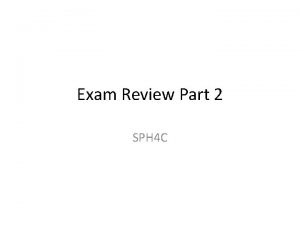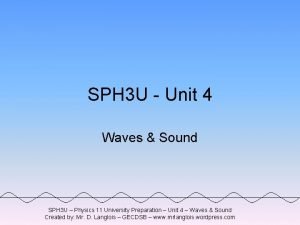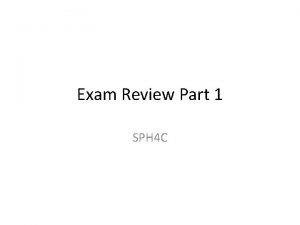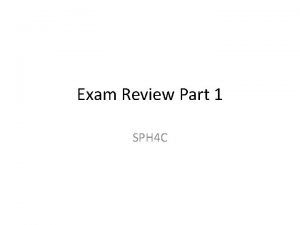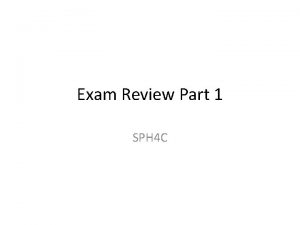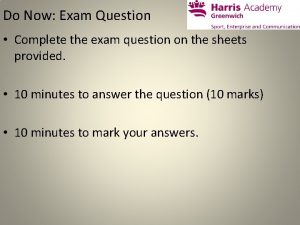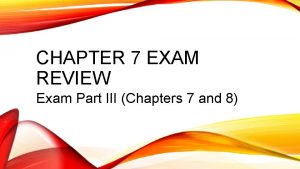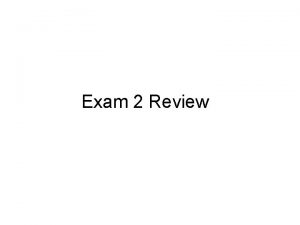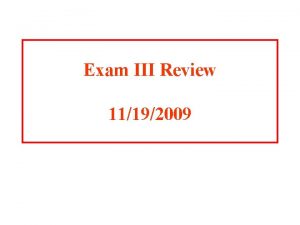Exam Review Part 2 SPH 4 C Question




























![Question 5 Connor's car brakes exert a force of 12 000 N [backwards] over Question 5 Connor's car brakes exert a force of 12 000 N [backwards] over](https://slidetodoc.com/presentation_image_h2/c9cebb90a2916756b554bbc2901d56d0/image-29.jpg)
![Question 5 Connor's car brakes exert a force of 12 000 N [backwards] over Question 5 Connor's car brakes exert a force of 12 000 N [backwards] over](https://slidetodoc.com/presentation_image_h2/c9cebb90a2916756b554bbc2901d56d0/image-30.jpg)


























- Slides: 56

Exam Review Part 2 SPH 4 C

Question 1 Starting from rest, Jacob accelerates to a velocity of 4. 6 m/s [E] in 2. 0 s. (a) What was Jacob's acceleration?

Question 1 Starting from rest, Jacob accelerates to a velocity of 4. 6 m/s [E] in 2. 0 s. (a) What was Jacob's acceleration?

Question 1 Starting from rest, Jacob accelerates to a velocity of 4. 6 m/s [E] in 2. 0 s. (a) What was Jacob's acceleration?

Question 1 Starting from rest, Jacob accelerates to a velocity of 4. 6 m/s [E] in 2. 0 s. (a) What was Jacob's acceleration?

Question 1 Starting from rest, Jacob accelerates to a velocity of 4. 6 m/s [E] in 2. 0 s. (a) What was Jacob's acceleration?

Question 1 Starting from rest, Jacob accelerates to a velocity of 4. 6 m/s [E] in 2. 0 s. (a) What was Jacob's acceleration?

Question 1 (b) What was the distance Jacob travelled while accelerating?

Question 1 (b) What was the distance Jacob travelled while accelerating?

Question 1 (b) What was the distance Jacob travelled while accelerating?

Question 2 Dalton pushes a crate of weight 320 N across a horizontal floor with a force of 110 N. The coefficient of kinetic friction between the crate and the floor is 0. 30. (a) What is the magnitude of the frictional force acting on the crate?

Question 2 Dalton pushes a crate of weight 320 N across a horizontal floor with a force of 110 N. The coefficient of kinetic friction between the crate and the floor is 0. 30. (a) What is the magnitude of the frictional force acting on the crate?

Question 2 Dalton pushes a crate of weight 320 N across a horizontal floor with a force of 110 N. The coefficient of kinetic friction between the crate and the floor is 0. 30. (a) What is the magnitude of the frictional force acting on the crate?

Question 2 Dalton pushes a crate of weight 320 N across a horizontal floor with a force of 110 N. The coefficient of kinetic friction between the crate and the floor is 0. 30. (a) What is the magnitude of the frictional force acting on the crate?

Question 2 (b) What is the net force on the crate?

Question 2 (b) What is the net force on the crate?

Question 2 (b) What is the net force on the crate?

Question 2 (b) What is the net force on the crate?

Question 2 (b) What is the net force on the crate?

Question 3 Eric uses a force of 180 N to push a crate of weight 320 N at constant speed up a ramp with a length of 3. 6 m and a rise of 1. 2 m. (a) What is the ideal mechanical advantage of the ramp?

Question 3 Eric uses a force of 180 N to push a crate of weight 320 N at constant speed up a ramp with a length of 3. 6 m and a rise of 1. 2 m. (a) What is the ideal mechanical advantage of the ramp?

Question 3 (b) What is the actual mechanical advantage of the ramp?

Question 4 Victoria is trying to lift a crate using a lever as shown below. The crate has a weight of 1650 N and is 1. 8 m from the fulcrum. (a) What is the load torque on the lever?

Question 4 Victoria is trying to lift a crate using a lever as shown below. The crate has a weight of 1650 N and is 1. 8 m from the fulcrum. (a) What is the load torque on the lever?

Question 4 Victoria is trying to lift a crate using a lever as shown below. The crate has a weight of 1650 N and is 1. 8 m from the fulcrum. (a) What is the load torque on the lever?

Question 4 (b) If the effort force is applied 3. 1 m from the fulcrum, what is its magnitude?

Question 4 (b) If the effort force is applied 3. 1 m from the fulcrum, what is its magnitude?

Question 4 (b) If the effort force is applied 3. 1 m from the fulcrum, what is its magnitude?
![Question 5 Connors car brakes exert a force of 12 000 N backwards over Question 5 Connor's car brakes exert a force of 12 000 N [backwards] over](https://slidetodoc.com/presentation_image_h2/c9cebb90a2916756b554bbc2901d56d0/image-29.jpg)
Question 5 Connor's car brakes exert a force of 12 000 N [backwards] over a distance of 24 m along a level piece of highway. (a) Determine the work done by the brakes.
![Question 5 Connors car brakes exert a force of 12 000 N backwards over Question 5 Connor's car brakes exert a force of 12 000 N [backwards] over](https://slidetodoc.com/presentation_image_h2/c9cebb90a2916756b554bbc2901d56d0/image-30.jpg)
Question 5 Connor's car brakes exert a force of 12 000 N [backwards] over a distance of 24 m along a level piece of highway. (a) Determine the work done by the brakes.

Question 5 (b) Is the work in (a) positive or negative? What does this mean? The work done is negative.

Question 5 (b) Is the work in (a) positive or negative? What does this mean? The work done is negative. Friction is reducing the energy of the car.

Question 6 Brandan drops a 1. 5 kg water balloon from a 14 m high roof. (a) What is the gravitational potential energy of the balloon on the roof?

Question 6 Brandan drops a 1. 5 kg water balloon from a 14 m high roof. (a) What is the gravitational potential energy of the balloon on the roof?

Question 6 Brandan drops a 1. 5 kg water balloon from a 14 m high roof. (a) What is the gravitational potential energy of the balloon on the roof?

Question 6 (b) What is the speed of the balloon when it hits the ground?

Question 6 (b) What is the speed of the balloon when it hits the ground?

Question 7 9 -V is supplied to a circuit containing a single light bulb. The current through the circuit is 3. 0 A. (a) What is the resistance of the bulb?

Question 7 9 -V is supplied to a circuit containing a single light bulb. The current through the circuit is 3. 0 A. (a) What is the resistance of the bulb?

Question 7 9 -V is supplied to a circuit containing a single light bulb. The current through the circuit is 3. 0 A. (a) What is the resistance of the bulb?

Question 7 (b) What is the power consumed by the bulb?

Question 7 (b) What is the power consumed by the bulb?

Question 8 You have three resistors, each with a resistance of 12 -W. (a) What is their resistance if the resistors are in series?

Question 8 You have three resistors, each with a resistance of 12 -W. (a) What is their resistance if the resistors are in series?

Question 8 (b) What is their resistance if the resistors are in parallel?

Question 9 In a manometer filled with water, the difference between the heights of the two columns is 6 cm (0. 06 m). (a) What is the gauge pressure on the lower column?

Question 9 In a manometer filled with water, the difference between the heights of the two columns is 6 cm (0. 06 m). (a) What is the gauge pressure on the lower column?

Question 9 In a manometer filled with water, the difference between the heights of the two columns is 6 cm (0. 06 m). (a) What is the gauge pressure on the lower column?

Question 9 In a manometer filled with water, the difference between the heights of the two columns is 6 cm (0. 06 m). (a) What is the gauge pressure on the lower column?

Question 9 In a manometer filled with water, the difference between the heights of the two columns is 6 cm (0. 06 m). (a) What is the gauge pressure on the lower column?

Question 9 (b) What is the absolute pressure on the lower column?

Question 10 In a hydraulic press, the master cylinder with an area of 0. 04 m 2 applies a force of magnitude 110 N. (a) What is the pressure applied by the master cylinder?

Question 10 In a hydraulic press, the master cylinder with an area of 0. 04 m 2 applies a force of magnitude 110 N. (a) What is the pressure applied by the master cylinder?

Question 10 (a) What is the magnitude of the force on the slave cylinder if it has an area of 0. 24 m 2?

Question 10 (a) What is the magnitude of the force on the slave cylinder if it has an area of 0. 24 m 2?

Question 10 (a) What is the magnitude of the force on the slave cylinder if it has an area of 0. 24 m 2?
 Costa's level of thinking
Costa's level of thinking Writ of certiorari ap gov example
Writ of certiorari ap gov example Sph toons
Sph toons Netgear sph
Netgear sph Sph +3
Sph +3 Ohsu sph
Ohsu sph Sph 4 inches
Sph 4 inches Sph surface tension
Sph surface tension Sph cah toa
Sph cah toa Social work saxion
Social work saxion Chapter review motion part a vocabulary review answer key
Chapter review motion part a vocabulary review answer key Analysis of young and dyslexic
Analysis of young and dyslexic War photographer questions and answers
War photographer questions and answers Security architecture for systems engineer sase 500 651
Security architecture for systems engineer sase 500 651 Example exam
Example exam Edexcel igcse anthology
Edexcel igcse anthology Cobit 2019 exam questions
Cobit 2019 exam questions Exam question
Exam question Wipo dl 101
Wipo dl 101 Fce speaking test part 3
Fce speaking test part 3 Semester a exam part 1
Semester a exam part 1 Pet speaking part 1
Pet speaking part 1 World history spring final exam review answers
World history spring final exam review answers You template
You template Spanish 2 final exam
Spanish 2 final exam Spanish 1 answers
Spanish 1 answers Pltw human body systems final exam
Pltw human body systems final exam Truss practice problems poe
Truss practice problems poe Rcgp akt questions
Rcgp akt questions Ied final exam
Ied final exam Hbs eoc study guide
Hbs eoc study guide World history b semester exam review practice
World history b semester exam review practice Principles of business final exam answer key
Principles of business final exam answer key Spanish 2 review packet answers
Spanish 2 review packet answers Environmental science final review
Environmental science final review Apes ap exam review
Apes ap exam review World history final exam review
World history final exam review Us history semester 2 final exam review
Us history semester 2 final exam review English 11 first semester exam
English 11 first semester exam Review for exam pronouns
Review for exam pronouns Physics fall final exam review
Physics fall final exam review Zoology semester 1 exam review answers
Zoology semester 1 exam review answers Eduqas online exam review
Eduqas online exam review Physics fall semester review answers
Physics fall semester review answers Us history semester 2 final exam
Us history semester 2 final exam English 3 fall semester exam review
English 3 fall semester exam review Sph3u exam review
Sph3u exam review Chemistry semester 1 exam review answers
Chemistry semester 1 exam review answers Physics 1 exam 2 review
Physics 1 exam 2 review Physics exam 2 review
Physics exam 2 review Physical science final exam study guide
Physical science final exam study guide Statics exam 2 review
Statics exam 2 review Mat1033c
Mat1033c Fe exam statics review
Fe exam statics review World history fall final review answers
World history fall final review answers Earth science final exam
Earth science final exam Chemistry 1 semester exam review
Chemistry 1 semester exam review


